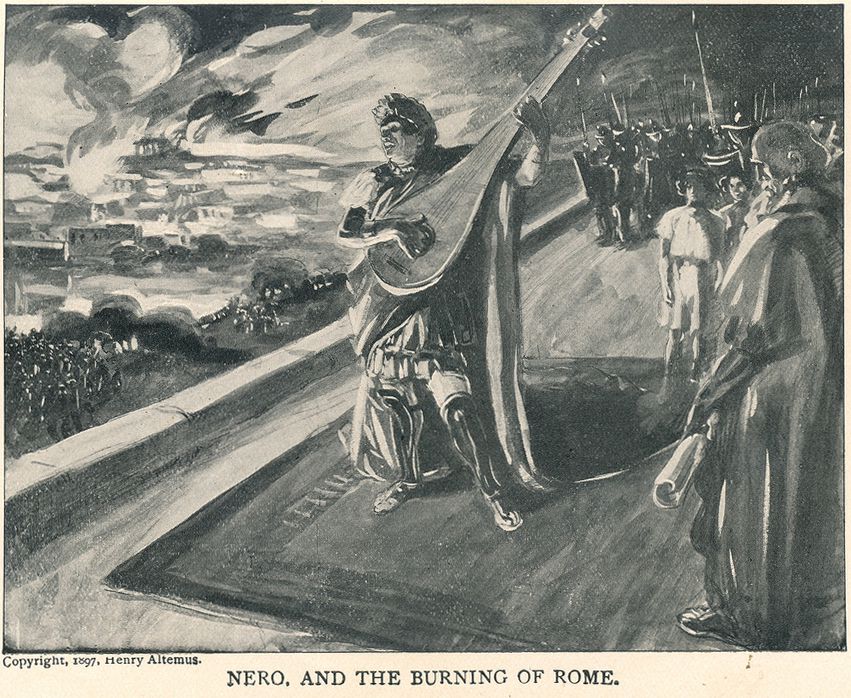For six days in July 64, the city of Rome was consumed by fire.
 Summer temperatures and winds were already high; many buildings were made of wood and poorly constructed; and, according to some sources, high-ranking officials hampered efforts to control the blaze. As a result, many people died and 10 of the 14 city regions were either heavily affected or ruined. To this day, historians cannot agree on some basic elements of the story, including who, if anyone, might have caused the blaze.
Summer temperatures and winds were already high; many buildings were made of wood and poorly constructed; and, according to some sources, high-ranking officials hampered efforts to control the blaze. As a result, many people died and 10 of the 14 city regions were either heavily affected or ruined. To this day, historians cannot agree on some basic elements of the story, including who, if anyone, might have caused the blaze.
Rome at that time was a city of 2 million people, many of whom were poor, living in slums. It was in one of these areas, at the Capena Gate, a marketplace near the huge stadium Circus Maximus, that the fire began, late on the night of July 18. The stadium quickly went up in flames, as did a large part of the city. Hot summer winds fanned the flames.
According to the historian Tacitus:
Breaking out in shops selling inflammable goods, and fanned by the wind, the conflagration instantly grew and swept the whole length of the Circus. There were no walled mansions or temples, or any other obstructions, which could arrest it. First, the fire swept violently over the level spaces. Then it climbed the hills—but returned to ravage the lower ground again. It outstripped every counter-measure. The ancient city's narrow winding streets and irregular blocks encouraged its progress.
Tacitus says that "menacing gangs" prevented people from battling the blaze and, further, threw torches on the flames, to stoke the fires higher. He is not the only historian to assert this. Cassius Dio agreed: "Many [houses] were set on fire by the same men who came to lend assistance." And further, Dio said, it wasn't menacing gangs who were to blame: "The soldiers, including the night watch, having an eye to plunder, instead of putting out fires, kindled new ones."
Looting was widespread. Thousands were left homeless and penniless.
In the aftermath, Rome rebuilt, following a blueprint set out by the emperor, Nero.
 Nero is one of the people who gets blamed for the fire damage, either by ordering the fire started or ordering soldiers to keep it burning. The theory goes that Nero wanted to see many new buildings constructed but, seeing his plans stymied by the Senate, resorted to other means to make way for his new construction.
Nero is one of the people who gets blamed for the fire damage, either by ordering the fire started or ordering soldiers to keep it burning. The theory goes that Nero wanted to see many new buildings constructed but, seeing his plans stymied by the Senate, resorted to other means to make way for his new construction.
The emperor wasn't in Rome when the fire began, according to most historians, including Tacitus. Rather, he was in the resort town of Antium. Some historians say that he rushed back to Rome when he heard about the fire and offered much assistance to people displaced by the fire. One source says that he personally pitched in to try to fight the fire.
However, one of the most commonly mentioned elements of the saga of the Great Fire of Rome is that Nero sang and played his lyre, as if celebrating the burning of the city. Cassius Dio writes that Nero grabbed his lyre, climbed to the roof of his imperial palace, and belted out a song called "Capture of Troy" while watching the flames grow. Another historian, Suetonius, echoes that sentiment, placing Nero in a different place in the city and singing a slightly different song but still playing the lyre and generally ignoring the devastation all around him.
Many students of history rely on these three historians for a great many details about Rome, its people, and its famous and mundane events. Another source, Flavius Josephus, didn't mention the Great Fire at all in his writings about Nero.
What is known is that among the buildings destroyed by the fire were a great many residences, including those of many aristocrats and Senators and the Domus Transitoria, Nero's personal palace, which was very large indeed. The fire also destroyed a large part of the Forum, home to the Senate and the government.
Nero had wanted to see a large part of the city torn down so he could have constructed a series of palaces known as Neropolis. Out of the ashes of devastation wrought by the Great Fire, Nero had constructed a great palace known as the Domus Aurea.
Nero did play the lyre; he was known for being musically talented, especially playing the lyre, and for composing his own music.
Nero is also suspected in the deaths of his uncle, Claudius, who preceded Nero on the imperial throne, and of Nero's own mother, Agrippina. Nero has become known for his ambition and his cruelty.
To many observers, these are evidence to advance the argument that Nero had a hand in the devastation.
Nero himself blamed someone else for starting the blaze. Several sources, Tacitus among them, say that Nero blamed members of the relatively new faith known as Christians for starting the fire. Certainly, after the Great Fire, Nero endorsed and encouraged the persecution of Christian people in Roman lands.
Many historians blame no one for the fire, saying that it was an accident. Fires were commonplace in that place at that time, as elsewhere.